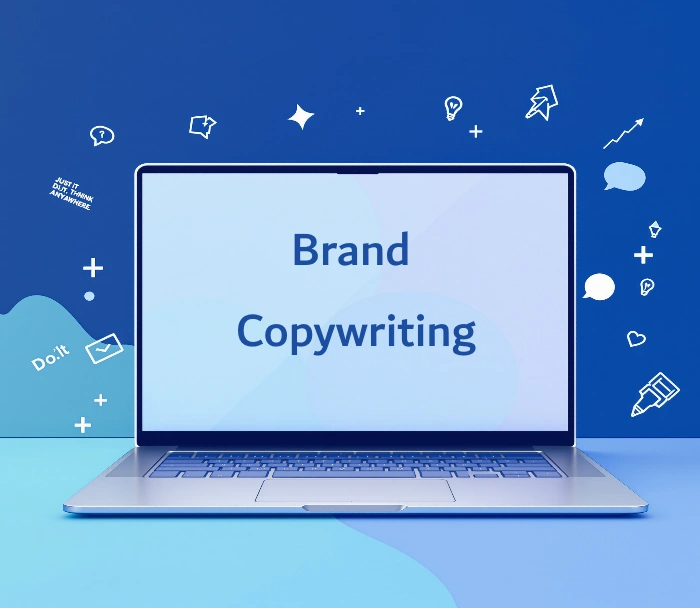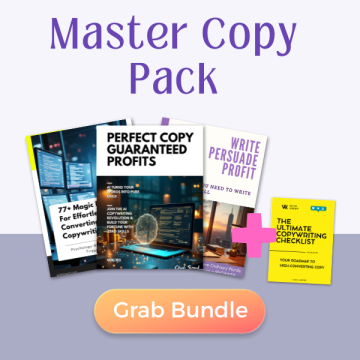Ever stared at a blank page, wondering how the heck to make your brand sound different from everyone else? I’ve been there. Three years ago, I couldn’t tell good brand copy from bad if my career depended on it. But studying brand copywriting examples from companies that actually convert changed everything. These aren’t just pretty words—they’re strategic messaging that drives real business results.
Here’s what separates amateur copy from pro-level brand messaging. The best brand copywriting examples don’t just sound clever. They solve specific problems for specific people while staying true to the brand’s personality.
What Makes Brand Copywriting Different from Regular Copy?
Brand copywriting isn’t just writing that mentions your company name. It’s messaging that embodies your brand’s personality, values, and unique position in the market.
Regular copy sells products. Brand copy sells experiences, feelings, and belonging.
Think about it this way: product copy says “Buy our running shoes.” Brand copy says “Just Do It.” One focuses on features. The other taps into human motivation and identity.
The best brand copy creates an emotional connection that goes beyond the transaction. It makes people feel something. And when people feel something, they remember you.
Related articles:
- B2B Copywriting Examples That Broke All the Rules
- PAS Copywriting Examples That Tripled My Conversion Rate
- AIDA Copywriting Examples: Real Templates That Made Millions
- 15 Freelance Copywriting Examples That’ll Land You More Clients
Nike: Emotional Motivation That Transcends Sports
“Just Do It”
This three-word masterpiece launched in 1988 and still dominates today. Why? Because it’s not about shoes at all.
Nike understood something profound: their real competition wasn’t Adidas or Reebok. It was the voice in your head saying “I can’t.”
The genius lies in the universality. Whether you’re training for a marathon or finally cleaning your garage, “Just Do It” applies. It’s permission to stop overthinking and start acting.
Key takeaway: Your brand copy should address the internal barriers your customers face, not just external problems.
Apple: Simplicity as a Luxury Statement
“Think Different”
Apple’s brand copy consistently positions complexity as the enemy. Their messaging suggests that true sophistication comes from simplicity.
Check out their iPhone launch copy: “This changes everything. Again.”
Seven words. No technical specs. No feature lists. Just confidence that you already know this matters.
Their product descriptions follow the same pattern:
- “The most personal device ever”
- “Your entire music library in your pocket”
- “A thousand songs in your pocket”
Key takeaway: Don’t explain your product. Express what it enables.
Oatly: Personality-Driven Disruption
“It’s like milk, but made for humans”
Oatly transformed boring oat milk into a movement through pure personality. Their copy is conversational, slightly irreverent, and unafraid to take positions.
Sample packaging copy: “Wow, no cow! And definitely no arrogance or indifference towards humans or the environment.”
They’re not just selling dairy alternatives. They’re selling a worldview that questions conventional choices.
Key takeaway: Strong brand copy takes a stance. Neutral messaging attracts no one.
Mailchimp: Making Complex Simple Through Humor
“Send better email”
Mailchimp democratized email marketing by making it approachable. Their copy consistently removes intimidation from marketing technology.
Their onboarding copy exemplifies this: “We’ll help you find your people. Then you can annoy them with emails.”
This self-deprecating humor acknowledges the reality of email marketing while positioning Mailchimp as the friendly guide, not the intimidating expert.
Key takeaway: Humor can humanize complex products, but it must serve the brand strategy, not overshadow it.
Dollar Shave Club: Disruption Through Direct Communication
“Shave Time. Shave Money.”
Dollar Shave Club obliterated the premium razor market with copy that called out industry BS directly.
Their launch video script became legendary: “Do you like spending $20 on a razor blade? Nineteen go to Roger Federer.”
This wasn’t just product positioning. It was cultural commentary wrapped in brand messaging.
Key takeaway: Sometimes the best brand copy directly challenges industry conventions.
Patagonia: Values-First Messaging
“Don’t Buy This Jacket”
Patagonia’s Black Friday ad campaign featured their jacket with this headline. Counterintuitive? Absolutely. Effective? Revenue increased 30% that day.
Their copy consistently prioritizes environmental values over short-term sales:
- “The activism company that happens to make clothes”
- “We’re in business to save our home planet”
Key takeaway: Authentic values-based messaging builds deeper customer relationships than feature-benefit copy.
Spotify: Personal Connection at Scale
“Thanks 2023, it’s been weird”
Spotify’s year-end campaigns turn user data into personal brand moments. Their copy makes millions of users feel individually seen.
Sample personalized copy:
- “You listened to ‘Bohemian Rhapsody’ 67 times. We’re not judging.”
- “Your listening habits are… unique.”
Key takeaway: Great brand copy can make mass communication feel personal.
Airbnb: Transformation Over Transaction
“Belong Anywhere”
Airbnb doesn’t sell accommodations. They sell belonging. Their copy consistently focuses on transformation rather than transaction.
Property listing copy follows this pattern:
- “Wake up in a real neighborhood”
- “Live like a local”
- “Create memories that matter”
Key takeaway: Focus copy on the transformation your product creates, not the features it includes.
Slack: Productivity Through Personality
“Where work happens”
Slack made workplace communication tools feel human. Their copy balances professionalism with personality.
Feature descriptions avoid jargon:
- “Less email. More productive conversations.”
- “All your team communication in one place”
- “Work, simplified”
Key takeaway: B2B copy doesn’t have to be boring. Professional can still be personable.
Innocent Drinks: Conversational Brand Voice
“Little tasty drinks for grown-ups”
Innocent built a multimillion-dollar brand through conversational copy that never takes itself too seriously.
Bottle copy examples:
- “This smoothie contains 1 of your 5 a day. The other 4 are up to you. No pressure.”
- “Keep me cold and drink me quick. I’m fresh and I don’t like hanging around.”
Key takeaway: Consistent voice across all touchpoints builds brand recognition faster than visual identity alone.
Tesla: Aspiration Through Innovation
“Accelerating the world’s transition to sustainable transport”
Tesla’s copy positions car buyers as world-changers. Every message reinforces the bigger mission.
Product copy emphasizes transformation:
- “The future of driving”
- “Zero emissions. Maximum impact.”
- “Designed for efficiency. Built for performance.”
Key takeaway: Connect product benefits to larger aspirations your customers hold.
Warby Parker: Democratic Luxury
“Eyewear for everyone”
Warby Parker democratized designer eyewear through copy that challenged industry gatekeeping.
Their messaging consistently emphasizes accessibility:
- “Glasses shouldn’t cost more than your phone”
- “Try 5 pairs at home for free”
- “Designer eyewear starting at $95”
Key takeaway: Position your brand as the accessible alternative to overpriced incumbents.
The Psychology Behind Great Brand Copy
Why do these brand copywriting examples work so well? They understand human psychology.
Great brand copy operates on three levels:
Rational: Addresses logical needs and concerns Emotional: Triggers feelings and desires
Social: Reinforces identity and belonging
The best messaging hits all three simultaneously. Nike’s “Just Do It” works because it’s rational advice (take action), emotional motivation (overcome fear), and social identity (be an athlete).
5 Templates You Can Steal for Your Brand
Based on analyzing hundreds of successful brand copywriting examples, here are proven templates that work:
Template 1: The Challenger
“While everyone else [industry standard], we [different approach]”
Example: “While everyone else makes complicated fitness apps, we make working out simple.”
Template 2: The Enabler
“We help [target audience] [desired outcome] without [common barrier]”
Example: “We help busy entrepreneurs build their brand without hiring expensive agencies.”
Template 3: The Transformation
“Transform from [current state] to [desired state] in [timeframe]”
Example: “Transform from confused beginner to confident copywriter in 30 days.”
Template 4: The Question
“What if [assumption challenge]?”
Example: “What if networking didn’t have to feel fake?”
Template 5: The Declaration
“[Strong belief statement]. Here’s how we’re changing it.”
Example: “Marketing shouldn’t be confusing. Here’s how we’re changing it.”
How to Develop Your Brand’s Copy Style
Finding your brand voice isn’t about copying what works for others. It’s about discovering what’s authentically you.
Start with these questions:
If your brand was a person at a party, how would they act? Formal or casual? Loud or thoughtful? Funny or serious?
What does your brand believe that others don’t? Your contrarian viewpoint becomes your messaging differentiator.
How does your brand make people feel? Confident? Inspired? Understood? Safe? That emotion should infuse every message.
What’s your brand’s superpower? The one thing you do better than anyone else becomes your copy’s core message.
Remember, consistency matters more than perfection. I’d rather see okay copy used consistently than brilliant copy used sporadically.
Common Brand Copy Mistakes (And How to Fix Them)
Mistake #1: Trying to appeal to everyone Generic messaging attracts no one. Be specific about who you serve.
Mistake #2: Leading with features instead of benefits Features tell. Benefits sell. Transformations create customers for life.
Mistake #3: Using industry jargon Your customers don’t speak your internal language. Write for them, not your colleagues.
Mistake #4: Inconsistent voice across channels Your social media voice should match your website voice. Confusion kills conversion.
Mistake #5: Copying competitors Following the leader makes you a follower. Find your unique angle.
Testing Your Brand Copy
Great copy gets better through testing. Here’s how to validate your messaging:
A/B test headlines on your homepage, emails, and ads. Small changes can create big improvements.
Survey your customers about which messages resonate. Their language should become your language.
Monitor social comments to see how people naturally describe your brand. That’s often your best copy inspiration.
Track conversion rates across different messaging approaches. Data beats opinions every time.
FAQ
Q: How long should brand copy be?
Length depends on context and complexity. Headlines should be 6-12 words. Email subject lines under 50 characters. Social posts vary by platform. But remember: every word should earn its place.
Q: Can I use these examples directly for my brand?
Don’t copy the words. Study the strategy. These brand copywriting examples work because they’re authentic to those specific brands. Your copy should be authentic to yours.
Q: How often should I update my brand copy?
Core messaging should remain consistent for years. Tactical copy (ads, emails, social posts) should evolve regularly based on performance and market changes.
Q: What’s the difference between brand copy and marketing copy?
Brand copy expresses your identity and values. Marketing copy drives specific actions. The best campaigns blend both seamlessly.
Q: Should B2B brands use personality in their copy?
Absolutely. B2B buyers are still humans who respond to personality. Professional doesn’t mean boring.
Conclusion
The best brand copywriting examples share common traits: they’re specific, emotional, and authentically represent their brand’s unique perspective. They don’t try to be everything to everyone.
Your brand deserves copy that works as hard as you do. Start with one template from this guide. Test it. Refine it. Make it authentically yours.
Great brand copy isn’t about finding the perfect words. It’s about finding the words that perfectly represent you. And honestly? That’s way more achievable than most people think.
The brands that win don’t necessarily have the biggest budgets. They have the clearest messages. What’s yours going to be?

